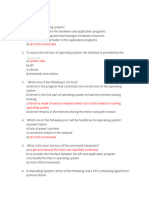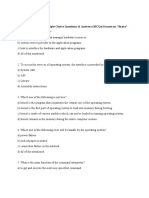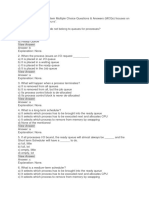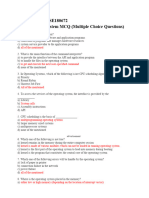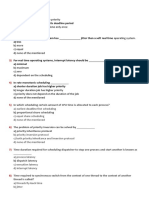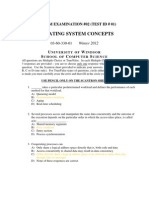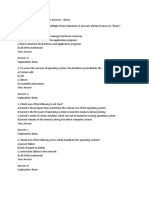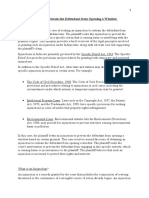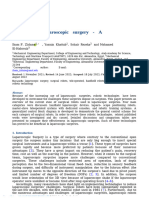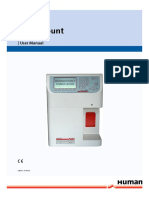MCQ Os
MCQ Os
Uploaded by
kushagra sharmaCopyright:
Available Formats
MCQ Os
MCQ Os
Uploaded by
kushagra sharmaOriginal Description:
Original Title
Copyright
Available Formats
Share this document
Did you find this document useful?
Is this content inappropriate?
Copyright:
Available Formats
MCQ Os
MCQ Os
Uploaded by
kushagra sharmaCopyright:
Available Formats
1. What is an operating system?
a) collection of programs that manages hardware resources
b) system service provider to the application programs
c) interface between the hardware and application programs
d) all of the mentioned
Answer: d
Explanation: An Operating System acts as an intermediary between user/user
applications/application programs and hardware. It is a program that manages hardware
resources. It provides services to application programs.
2. A Process Control Block(PCB) does not contain which of the following?
a) Code
b) Stack
c) Bootstrap program
d) Data
Answer: c
Explanation: Process Control Block (PCB) contains information related to a process such as
Process State, Program Counter, CPU Register, etc. Process Control Block is also known
as Task Control Block. Bootstrap program is a program which runs initially when the system
or computer is booted or rebooted.
3. The number of processes completed per unit time is known as __________
a) Output
b) Throughput
c) Efficiency
d) Capacity
4. What is a long-term scheduler?
a) It selects processes which have to be brought into the ready queue
b) It selects processes which have to be executed next and allocates CPU
c) It selects processes which heave to remove from memory by swapping
d) None of the mentioned
5. What is a short-term scheduler?
a) It selects which process has to be brought into the ready queue
b) It selects which process has to be executed next and allocates CPU
c) It selects which process to remove from memory by swapping
d) None of the mentioned
6. In a time-sharing operating system, when the time slot given to a process is
completed, the process goes from the running state to the __________
a) Blocked state
b) Ready state
c) Suspended state
d) Terminated state
7. The context of a process in the PCB of a process does not contain __________
a) the value of the CPU registers
b) the process state
c) memory-management information
d) context switch time
8. Which module gives control of the CPU to the process selected by the short-term
scheduler?
a) dispatcher
b) interrupt
c) scheduler
d) none of the mentioned
9. The interval from the time of submission of a process to the time of completion is
termed as ____________
a) waiting time
b) turnaround time
c) response time
d) throughput
10. In priority scheduling algorithm, when a process arrives at the ready queue, its
priority is compared with the priority of ____________
a) all process
b) currently running process
c) parent process
d) init process
11. In multilevel feedback scheduling algorithm ____________
a) a process can move to a different classified ready queue
b) classification of ready queue is permanent
c) processes are not classified into groups
d) none of the mentioned
12. Concurrent access to shared data may result in ____________
a) data consistency
b) data insecurity
c) data inconsistency
d) none of the mentioned
13. The segment of code in which the process may change common variables, update
tables, write into files is known as ____________
a) program
b) critical section
c) non – critical section
d) synchronizing
View Answer
14. Which of the following conditions must be satisfied to solve the critical section
problem?
a) Mutual Exclusion
b) Progress
c) Bounded Waiting
d) All of the mentioned
15. Bounded waiting implies that there exists a bound on the number of times a process
is allowed to enter its critical section ____________
a) after a process has made a request to enter its critical section and before the
request is granted
b) when another process is in its critical section
c) before a process has made a request to enter its critical section
d) none of the mentioned
16. Which of the following condition is required for a deadlock to be possible?
a) mutual exclusion
b) a process may hold allocated resources while awaiting assignment of other
resources
c) no resource can be forcibly removed from a process holding it
d) all of the mentioned
17. A system is in the safe state if ____________
a) the system can allocate resources to each process in some order and still avoid a
deadlock
b) there exist a safe sequence
c) all of the mentioned
d) none of the mentioned
18. The circular wait condition can be prevented by ____________
a) defining a linear ordering of resource types
b) using thread
c) using pipes
d) all of the mentioned
19. Which one of the following is the deadlock avoidance algorithm?
a) banker’s algorithm
b) round-robin algorithm
c) elevator algorithm
d) karn’s algorithm
20. Which one of the following is a visual ( mathematical ) way to determine the
deadlock occurrence?
a) resource allocation graph
b) starvation graph
c) inversion graph
d) none of the mentioned
21. TestAndSet instruction is executed ____________
a) after a particular process
b) periodically
c) atomically
d) none of the mentioned
22. Given a priori information about the ________ number of resources of each type that
maybe requested for each process, it is possible to construct an algorithm that
ensures that the system will never enter a deadlock state.
a) minimum
b) average
c) maximum
d) approximate
23. All unsafe states are ____________
a) deadlocks
b) not deadlocks
c) fatal
d) none of the mentioned
24. CPU fetches the instruction from memory according to the value of ____________
a) program counter
b) status register
c) instruction register
d) program status word
25. Which one of the following is the address generated by CPU?
a) physical address
b) absolute address
c) logical address
d) none of the mentioned
26. Physical memory is broken into fixed-sized blocks called ________
a) frames
b) pages
c) backing store
d) none of the mentioned
27. If a page number is not found in the TLB, then it is known as a ____________
a) TLB miss
b) Buffer miss
c) TLB hit
d) All of the mentioned
28. Every address generated by the CPU is divided into two parts. They are
____________
a) frame bit & page number
b) page number & page offset
c) page offset & frame bit
d) frame offset & page offset
29. In segmentation, each address is specified by ____________
a) a segment number & offset
b) an offset & value
c) a value & segment number
d) a key & value
30. Each entry in a segment table has a ____________
a) segment base
b) segment peak
c) segment value
d) none of the mentioned
You might also like
- 4 MCQ DBMSDocument25 pages4 MCQ DBMSRutuja100% (2)
- Pakistan Violence Versus StabilityDocument217 pagesPakistan Violence Versus StabilityAfPakWars100% (2)
- Mine Planning DesignDocument89 pagesMine Planning Designkhatonshughni86% (7)
- Processes: All of The MentionedDocument21 pagesProcesses: All of The Mentionedabdo hussienNo ratings yet
- OS RevDocument18 pagesOS RevMahmoud ElmahdyNo ratings yet
- SPPU All Course MCQ: All MCQ PDF Format Mba / Be /ba /engieenaring / BSC /MSC /bca/ BcomDocument8 pagesSPPU All Course MCQ: All MCQ PDF Format Mba / Be /ba /engieenaring / BSC /MSC /bca/ BcomQueency FernandesNo ratings yet
- Which of The Following Is Not An Important Functions of An Operating System?Document9 pagesWhich of The Following Is Not An Important Functions of An Operating System?PratikNo ratings yet
- TYBSC Computer Science SEM VI UG CS 321 Operating SystemDocument47 pagesTYBSC Computer Science SEM VI UG CS 321 Operating SystemPriyanka MahajanNo ratings yet
- MCQS OsDocument93 pagesMCQS OsYashu GowdaNo ratings yet
- MCQ On OS Per AKTU Syllabus (Part-1) )Document131 pagesMCQ On OS Per AKTU Syllabus (Part-1) )Rajeev BansalNo ratings yet
- Os QuizDocument3 pagesOs QuizShreyaNo ratings yet
- Operating System Questions PDFDocument225 pagesOperating System Questions PDFOwaisAhmedNo ratings yet
- OS Quiz - DKT SirDocument10 pagesOS Quiz - DKT SirAditya ShuklaNo ratings yet
- Os MCQDocument27 pagesOs MCQAmosNo ratings yet
- Operating SystemDocument8 pagesOperating SystemMahmoud ElmahdyNo ratings yet
- Os ConceptsDocument4 pagesOs ConceptsBhaskar SinNo ratings yet
- OS MCQDocument11 pagesOS MCQnoakhaliNo ratings yet
- This Set of Operating System Multiple Choice QuestionsDocument13 pagesThis Set of Operating System Multiple Choice QuestionsUsama ArshadNo ratings yet
- Class Test - 1 Students OSY Question Bank 2021-22Document3 pagesClass Test - 1 Students OSY Question Bank 2021-22114-Lobhan PatilNo ratings yet
- 2 - Fybca 203 Os1 Mcqbank - 2020 2021Document3 pages2 - Fybca 203 Os1 Mcqbank - 2020 2021rupeshpawar0086No ratings yet
- OS ToughDocument7 pagesOS ToughReoNo ratings yet
- CMPS Comprehensive Exam MCQ PRACTICE QuestionsDocument75 pagesCMPS Comprehensive Exam MCQ PRACTICE QuestionsKOTHURU MNo ratings yet
- Ec8791 MCQ For ModelDocument7 pagesEc8791 MCQ For ModelVijayanand SNo ratings yet
- Important Questions From Module 3, 4 & 5: A Task Must Be Serviced by Its Deadline PeriodDocument4 pagesImportant Questions From Module 3, 4 & 5: A Task Must Be Serviced by Its Deadline Periodanupnaskar naskarNo ratings yet
- OSDocument5 pagesOSAmreen KhanNo ratings yet
- OSY MCQ Question BankDocument10 pagesOSY MCQ Question Bankjitupardhi2006No ratings yet
- Operating System (MCQS)Document35 pagesOperating System (MCQS)Noman AsifNo ratings yet
- Operating System Imp QuestionsDocument34 pagesOperating System Imp QuestionsEDU SUMMITNo ratings yet
- Course:Operatingsystem Course Code: - 22516 Semester:V MCQ Question BankDocument10 pagesCourse:Operatingsystem Course Code: - 22516 Semester:V MCQ Question Banksudarshan sonawaneNo ratings yet
- Operating System (OSY) MCQ 5iDocument10 pagesOperating System (OSY) MCQ 5iomkar Jadhav169No ratings yet
- OS Sheet (3) SolutionDocument11 pagesOS Sheet (3) Solutionhussienboss99No ratings yet
- Objective QuestionsDocument9 pagesObjective QuestionsKalpana MrcetNo ratings yet
- Syst Expl QCM Seance4Document9 pagesSyst Expl QCM Seance4OuerghiMohamedSaidNo ratings yet
- Mces MCQDocument50 pagesMces MCQshrimanNo ratings yet
- os mcq 25.02.2019Document7 pagesos mcq 25.02.2019dhana lalithaNo ratings yet
- Bca502: Core - 19: Operating Systems Multiple Choice QuestionsDocument29 pagesBca502: Core - 19: Operating Systems Multiple Choice QuestionsUrvishNo ratings yet
- Adv OS MCQDocument16 pagesAdv OS MCQsraveshNo ratings yet
- Computer Fundamental & OSDocument9 pagesComputer Fundamental & OSgopalmondal110No ratings yet
- Operating System Important Objective Question and Answer. For 4rth Semester PaperDocument38 pagesOperating System Important Objective Question and Answer. For 4rth Semester PaperbhuvneshNo ratings yet
- C1 OsgDocument7 pagesC1 OsgViệt NguyễnNo ratings yet
- ÔN TẬP CUỐI MÔN OSDocument16 pagesÔN TẬP CUỐI MÔN OSNguyễn Bảo HưngNo ratings yet
- Shriram Mantri Vidyanidhi Info Tech Academy: OS Question BankDocument9 pagesShriram Mantri Vidyanidhi Info Tech Academy: OS Question BankNikhil SabaleNo ratings yet
- Os MCQDocument14 pagesOs MCQmohamedmohy37173No ratings yet
- Os MCQDocument34 pagesOs MCQTechno PhileNo ratings yet
- Os mcq-1Document68 pagesOs mcq-1u6402018No ratings yet
- Objective Questions 1&2unitsDocument13 pagesObjective Questions 1&2unitsSheena MohammedNo ratings yet
- OS Sheet (3)Document9 pagesOS Sheet (3)alcinialbob1234No ratings yet
- Rtos - MCQDocument20 pagesRtos - MCQpavanNo ratings yet
- PPSC Computer Lecturer MCQDocument143 pagesPPSC Computer Lecturer MCQRana afaqNo ratings yet
- MCQ's For Operating SystemsDocument11 pagesMCQ's For Operating SystemsYussif AliNo ratings yet
- DCS MCQs Unit 1to4 SirDocument20 pagesDCS MCQs Unit 1to4 Sirakshata bhute100% (1)
- Rtos MCQDocument48 pagesRtos MCQshruti patilNo ratings yet
- HW 12.11.21Document6 pagesHW 12.11.2120IT019 ROHIT SNo ratings yet
- Operating System Concepts TestDocument11 pagesOperating System Concepts TestXuong RongNo ratings yet
- Os MCQDocument69 pagesOs MCQSantosh PhatangareNo ratings yet
- Multiple Choice Questions (MCQ) : Operating System (KCS401)Document51 pagesMultiple Choice Questions (MCQ) : Operating System (KCS401)Larry Wheels50% (2)
- Mcq Os AssignDocument20 pagesMcq Os Assignwww.infas7771No ratings yet
- Operating System MCQDocument29 pagesOperating System MCQpavithrakumarmba6109No ratings yet
- Operating System QuestionsDocument84 pagesOperating System Questionshafiz tahir100% (1)
- C1 Operating System MCQ - KeyDocument11 pagesC1 Operating System MCQ - Keyhuynt1910No ratings yet
- 20 - Fire Protection System - FPSDocument3 pages20 - Fire Protection System - FPSGreen MichaelsNo ratings yet
- Pricing DecisionsDocument30 pagesPricing Decisionsbhanu.chandu100% (1)
- Center of Rigidity - ETABS - CSIDocument2 pagesCenter of Rigidity - ETABS - CSIabdul khader100% (1)
- Changes: OPS: This Chart Is A Part of Navigraph Charts and Is Intended For Flight Simulation Use OnlyDocument20 pagesChanges: OPS: This Chart Is A Part of Navigraph Charts and Is Intended For Flight Simulation Use OnlydebertNo ratings yet
- Project Report On Railway Reservation System PDFDocument53 pagesProject Report On Railway Reservation System PDFsingh rajputNo ratings yet
- SSG Training MatrixDocument3 pagesSSG Training MatrixETHAN GIDEON Q. NARCISONo ratings yet
- Valerio Scacco PresentationDocument33 pagesValerio Scacco PresentationValerio ScaccoNo ratings yet
- Of and To Deliver A Determinate Thing, While The Other Party (Buyer or Vendee) Obligates HimselfDocument11 pagesOf and To Deliver A Determinate Thing, While The Other Party (Buyer or Vendee) Obligates HimselfDANICA FLORESNo ratings yet
- Identifying Core Categories of Client-Identified Impact of Helpful Events in Psychotherapy: A Qualitative Meta-AnalysisDocument13 pagesIdentifying Core Categories of Client-Identified Impact of Helpful Events in Psychotherapy: A Qualitative Meta-AnalysisFelipe Concha AquevequeNo ratings yet
- Data Table For Pumps: Pump CentrifugalDocument4 pagesData Table For Pumps: Pump CentrifugalJorge F. CastañedaNo ratings yet
- Audience fragmentation-CCM 425Document7 pagesAudience fragmentation-CCM 425boniface murimiNo ratings yet
- AssignmentDocument21 pagesAssignmentrashantNo ratings yet
- Ebook - A Complete Guide To Data BreachesDocument31 pagesEbook - A Complete Guide To Data BreachesEvery LootNo ratings yet
- Reset BaterieDocument4 pagesReset BaterieFlorin IonescuNo ratings yet
- Injunction For Restraining The Defendant From Opening The WindowDocument6 pagesInjunction For Restraining The Defendant From Opening The WindowSARIT GHOSHNo ratings yet
- (Rian) Robotics in Laprascopic SurgeryDocument80 pages(Rian) Robotics in Laprascopic Surgery24Rian Permana Putra BiasalahNo ratings yet
- Alonzo HerndonDocument4 pagesAlonzo HerndonAngonia Wonder ChitandizoNo ratings yet
- Phoenix Construction Vs IAC (1987)Document4 pagesPhoenix Construction Vs IAC (1987)Henry C. FlordelizaNo ratings yet
- Personal Data SheetDocument4 pagesPersonal Data SheetJoanne TolopiaNo ratings yet
- WFT255034 OmniWellDocument16 pagesWFT255034 OmniWellHugoNo ratings yet
- Voluson Signature18_20_5926566_Basic Service Manual_Rev2_SM_5926566_3Document396 pagesVoluson Signature18_20_5926566_Basic Service Manual_Rev2_SM_5926566_3imens1No ratings yet
- Гематологический Анализатор HumaCount (Human) РПDocument52 pagesГематологический Анализатор HumaCount (Human) РПvaklinNo ratings yet
- Make $100 in 10 Minutes: The Easiest Method I Have Ever Seen!Document3 pagesMake $100 in 10 Minutes: The Easiest Method I Have Ever Seen!Neill AndrewsNo ratings yet
- FORM TP 2013053: Caribbean Examinations Council Caribbean Secondary Education Certificate 'ExaminationDocument11 pagesFORM TP 2013053: Caribbean Examinations Council Caribbean Secondary Education Certificate 'ExaminationJoy NapierNo ratings yet
- Assignment 1.1 (Distri.)Document2 pagesAssignment 1.1 (Distri.)amol nagraleNo ratings yet
- Methanol MSDSDocument10 pagesMethanol MSDSRaja DhanasekaranNo ratings yet
- U2 Working & AuxiliaryDocument48 pagesU2 Working & AuxiliaryNurye Nigus100% (1)
- Elamkulam Manakkal Sankaran NamboodiripadDocument2 pagesElamkulam Manakkal Sankaran NamboodiripadsarayooNo ratings yet



